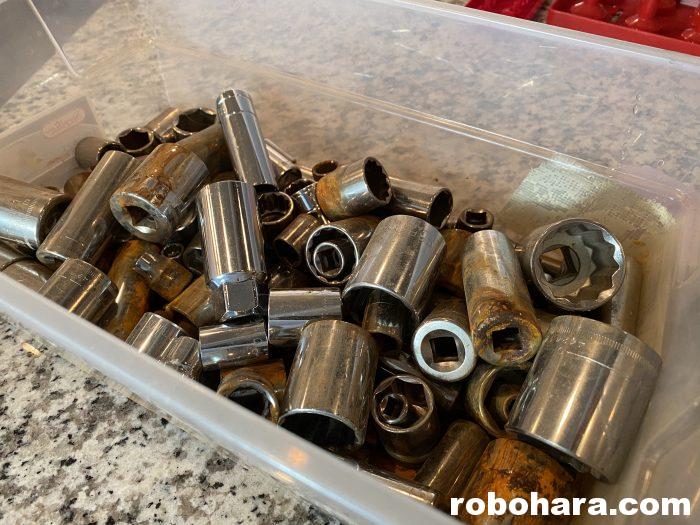
Around the time Susan and I bought our first house, my dad bought me my first set of big boy tools, which included a large tool chest and set of Craftsman tools. Back then I couldn’t tell nice tools from cheap ones, and probably didn’t appreciate them as much as I should have. Over the years I’ve purchased additional tools and mixed them all together.
Last year while moving, I emptied all of my tools out of my toolbox and haven’t yet put all of them back where they go. Recently while looking for a socket, I discovered that many of the ones I owned had rusted! None of them have ever been in or near water; heck, some of them have never even been used!
In preparation for my new shop, I recently ordered a plastic socket organizer. I decided to kill two birds with one stone — attempt to remove the rust from my sockets while sorting them and placing them into the new organizational system. This would also allow me to see if I was missing any specific sockets.
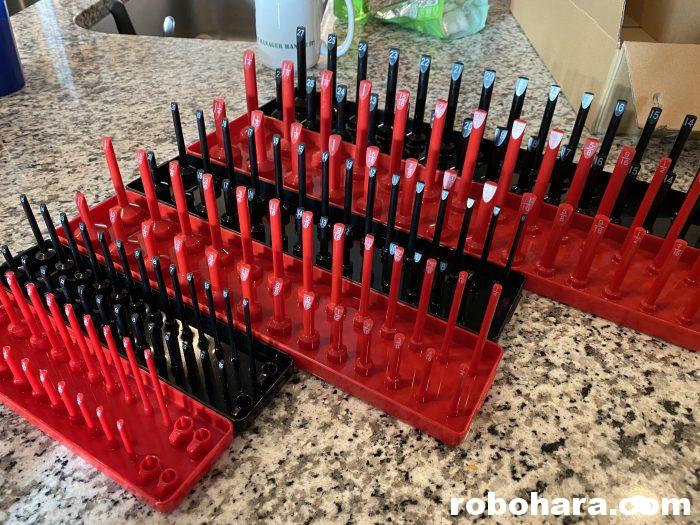
Like most projects, I turned to Google for ideas. Every forum post and YouTube tutorial hinged on performing two steps: soak the sockets in something, and then scrub the rust off with something else. I decided to soak mine in vinegar, mostly because vinegar is cheap. I purchased a gallon of vinegar and a steel brush from Home Depot for about $5.
Step one involved soaking rusty sockets in a tub of vinegar. I’m pretty good at soaking things. I split the sockets into two plastic tubs the size of a shoe box, and poured vinegar in the tub until all the sockets were covered. I let them soak for an hour in the kitchen before getting tired of the smell and moving them to the back porch.
The next day around noon, I brought the tubs inside and placed them on the kitchen counter. I poured the rusty vinegar water down the sink, combined the sockets into a single tub, and rinsed them with water
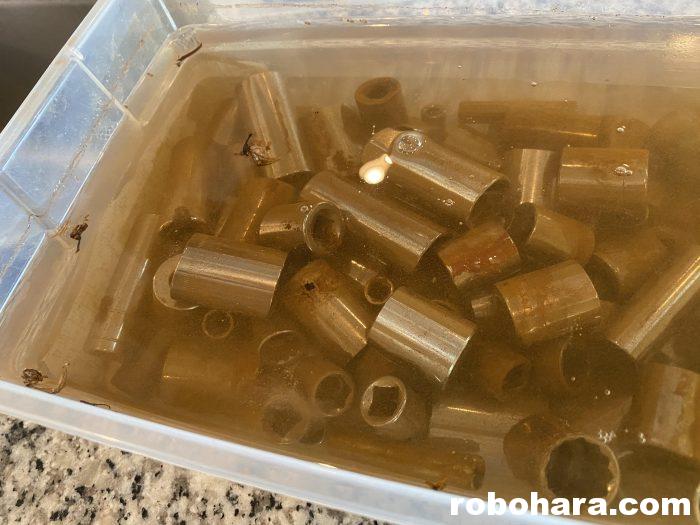
Not that it’s important to the story, but I started this project about ten minutes after every news channel announced Kobe Bryant had died. For about two hours I sat at my kitchen bar, scrubbing the rust off of sockets and watching the news.
Something I hadn’t anticipated was that all the sockets that hadn’t had any rust on them the day before now had rust on them. Each time I pulled a new socket out of the tub, I had to rub it with my thumb. If the rust rubbed right off, it was just dirty. If it didn’t. I moved to step two.
Step two involved scrubbing sockets with a wire brush. If I didn’t already mention it, while I was at Home Depot I bought a pair of dish washing gloves. (Purple, if you must know.) These proved invaluable during step two. The easiest way I found to scrub the sockets was to hold them between my thumb and forefinger with one hand, and scrub them aggressively with the brush. For the really rusty ones, I almost had to “hammer” them with the wire brush — not just scrub them, but really whack them with the brush. With almost every socket, the wire brush scraped across my thumb multiple times. Even with the gloves, it was sore by the time I was done. Without them, I suspect my thumb would have looked like hamburger meat.
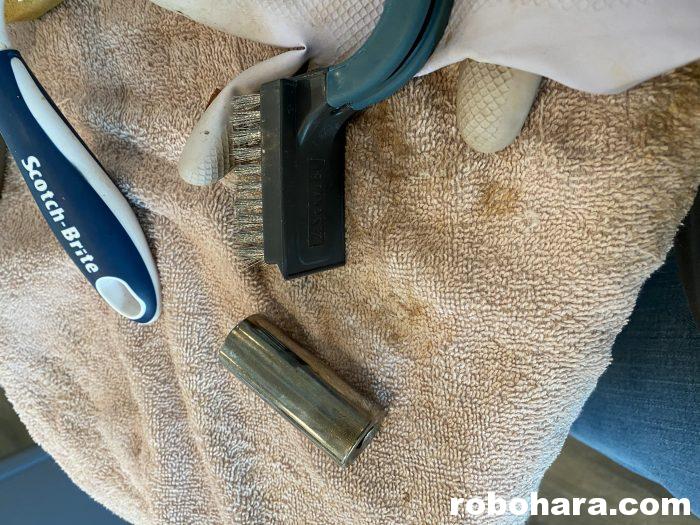
Before I started the project, I could not tell which sockets were the good (Craftsman) ones and which were the cheapos. The more I handled them, the more obvious it became. The easiest way to tell them apart was the fact that the cheap ones turned out to be the rusty ones, while the more expensive ones still had their original mirror finish. After a few minutes, I was able to tell the difference between the two based on their weights. The well-made sockets were thicker, heavier, and felt more solid.
Along those same lines, the organization stands I purchased off of Amazon didn’t make much sense to me at first. There were lots of duplicate sizes, and I thought I had ordered two before receiving six. After messing with the sockets for a few minutes it became pretty clear what went where, or at least what was intended to go where. (More on that in a minute.) It took me about two hours to work my way through all the sockets.
Here are my final thoughts on the experience.
I have a friend who assigns a financial value to his time, and if it’s cheaper for him to outsource a job, that’s what he does. Assuming I paid myself $10/hour, the whole project took three hours to complete and I purchased $5 in supplies for a total of $35. I checked Amazon, and there are lots of socket sets for sale there from $20-$40.
About halfway through my project, my father explained to me that the reason sockets rust is because the chrome layer has failed. Soaking them in vinegar and scrubbing them with a wire brush might remove the rust, but it’ll remove more of the chrome plating as well. He thinks the sockets will rust again, and more quickly next time. If they do, I’ll replace them.
Another takeaway is that many name brand tools come with lifetime warranty. This includes Craftsman, DeWalt, and the more affordable Husky. Also, I checked — the warranty includes rust. In many cases, all you have to do is walk into the place you purchased the tool and they’ll let you swap it with one right off the rack. If my sockets begin to rust again and I end up replacing them, I’ll be adding more Craftsmans to my collection. (For the record, the sockets I had with the most rust were so cheap they didn’t even have a brand name printed on them.)
Another suggested I heard online was to soak them in Coke or Pepsi before scrubbing. I don’t believe this would have worked any better than vinegar, and would have been more sticky. I also read that you can create a paste with baking soda and water that you can paint on the rusted area and then scrape off. Probably works; sounded like work.
Another product I ran across was Evapo-Rust, which comes highly recommended. It’s $22 for a one gallon jug. I’m sure it works great; for me, it didn’t make sense to spend $22 to restore $20 worth of sockets.
In summary — soaking tools in vinegar and scrubbing them with a wire brush worked, but the jury is still out on how long they’ll stay that way.
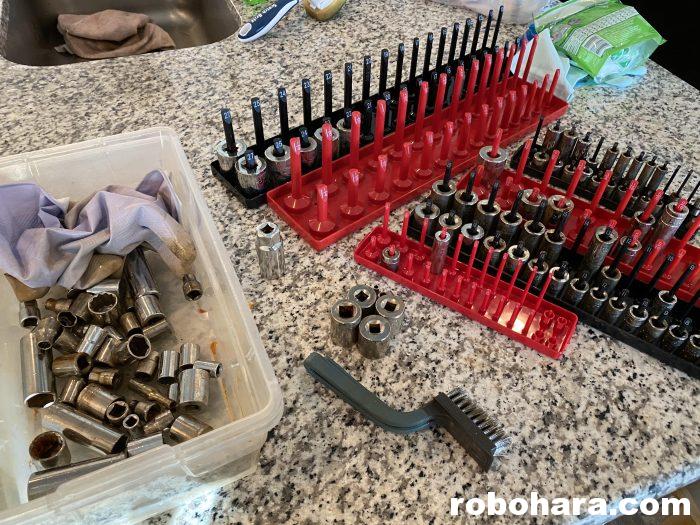
Just for the record, Evapo-Rust is not intended to be discarded after one job. It’s got a pretty high capacity to remove rust, and a gallon will handle many small jobs like this before it becomes ineffective. It’s not bad if you do this kind of thing regularly.